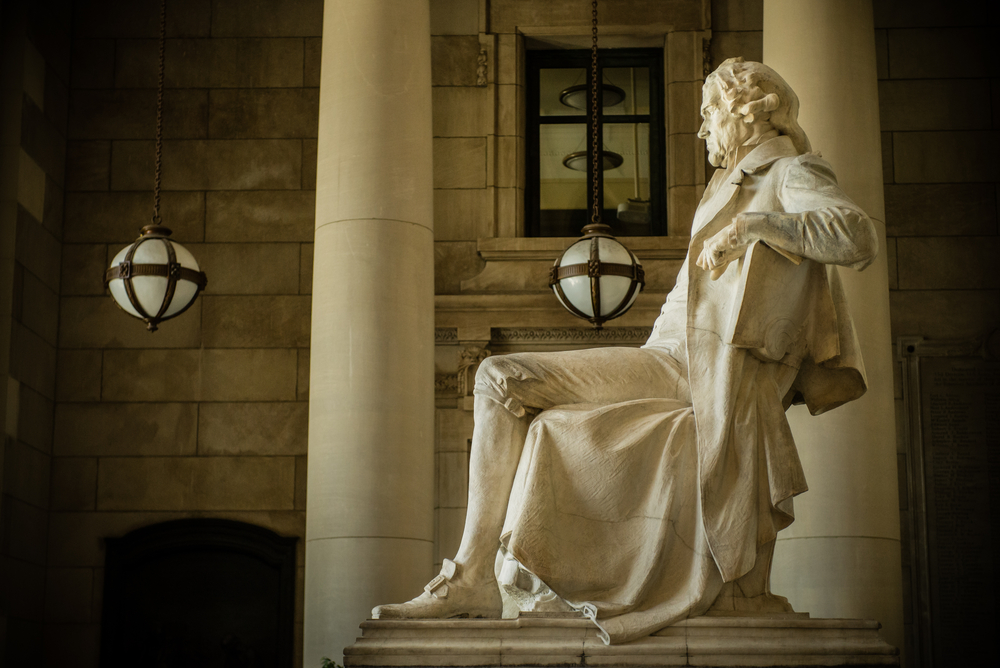Dispatch from the Monument Wars

The nationwide protests sparked by George Floyd’s murder that roiled the nation this summer provided additional impetus to a process that has been ongoing since 2015: the dismantling of Confederate monuments. The Southern Poverty Law Center recently reported that at least 168 Confederate symbols in public spaces — including statutes, institution names, plaques and markers — were removed or renamed last year. Increasingly, however, other monuments have come under activists’ and community leaders’ crosshairs.
Chicago’s experience is emblematic of this new trend. Over the summer, statues of Christopher Columbus became focal points of demonstrations across the city, leading Mayor Lori Lightfoot to remove the statues in the middle of the night. Lightfoot also formed a committee composed of community leaders, artists, architects, scholars, curators, and city officials to conduct a thorough review of other public works of art to assess if they should be removed or changed, promising an “inclusive and democratic public dialogue” about the future of Chicago’s internationally acclaimed public art collection.
A few weeks ago, the Chicago Monuments Project Advisory Committee released a list of 41 “problematic” artworks slated for review. The list included numerous statues of Abraham Lincoln and Christopher Columbus, as well as statues of Ulysses S. Grant, George Washington, Benjamin Franklin, and William McKinley. In an editorial in the Chicago Sun-Times, the co-chairs of the Committee suggested that the reason for Lincoln and Grant’s inclusion concerned their roles in the forcible removal of Native Americans from their land.
Despite, or perhaps because of, the fact that the Committee has not said what will be done with the monuments, the reaction in the local media has been mostly negative, with concerns about the transparency of the Committee’s deliberations — the Committee’s meetings during the first six months of work were kept secret — mingled with general alarm about the inclusion of great men on the list of works scheduled for review and possible removal. (No one seemed to shed a tear for the Italo Balbo Monument, which was gifted to the City of Chicago by fascist dictator Benito Mussolini). It is likely that those process concerns will be at least partly allayed by the Committee’s recent shift to a more public-facing posture, inviting feedback on its website, hosting a number of interactive speaker events, and soliciting proposals from artists for new monument ideas.
Still, an editorial in the Chicago Tribune is fairly representative of the local media response. “Take down Chicago statues of Lincoln? No.” makes two arguments. The first is that the moral standards of those who wish to reassess the commemorative landscape are too demanding: “some critics think every person we memorialize must be perfectly blameless by the standards of modern America.” The editorial sensibly replies that if this is the standard, then there will be no (or at least, very few) monuments. Because this is an obviously (?) undesirable result, those high standards ought to be abandoned. Instead, we should “weigh the good done by those who have been honored against their shortcomings, and in the context of their generation, not ours.” The second argument is that critics of the monuments are guilty of arrogance, believing that they are morally superior to “yesterday’s heroes.” Presumably, however, everyone has feet of clay, particularly by the standards of future generations. To avoid arrogance, then, we should not presume to stand in judgment of our forebears.
The Tribune’s arguments have the flavor of straw men, although it’s impossible to say whether they are right about at least some activists. At the heart of the Tribune’s argument is the assumption that activists are primarily interested in whether the subjects of monumental representations are blameworthy for what they’ve done by the standards of our own time. However, the much more relevant consideration seems to be what effect publicly expressing admiration for these men has on members of marginalized groups, regardless of whether they are to blame for what they did. Philosophers would distinguish these two considerations by calling the blameworthiness consideration backward-looking, concerning the basic desert of the subjects of monuments, while the consideration of effects is forward-looking, concerning the present and future consequences of honoring these individuals.
I have argued elsewhere that honoring individuals who either took part in, or expressed approval of, the oppression of currently marginalized groups can undermine the assurance of members of those groups that their basic moral and constitutional entitlements will be respected in their everyday interactions with others. Imagine for a moment living in a society in which individuals who approved of, or took part in, rights violations against members of the group to which you belong are the subjects of honorific monuments. Surely, this would make you doubt whether your society took your rights seriously. In my view, this is the primary, though not sole, reason why there is a strong prima facie moral case for modifying monuments to such individuals, and it has nothing to do with whether those individuals are blameworthy for what they did. Put another way: the movement to change the commemorative landscape should be about upholding the dignity of those who are currently marginalized, not punishing historical figures for past injustices. We need not stand in smug judgment of these figures in order to be concerned about the effects of honoring them.
If I am right about why we should care about these monuments, then there is good reason to consider how we honor figures like Lincoln and Grant. It’s not just that they were both morally flawed; more importantly given the considerations highlighted above, both of them played well-known roles in the oppression of Native Americans. Those roles should be emphasized in any honorific representation of these men in order to convey a properly balanced admiration tempered by acknowledgement of the injustices to which they contributed. This does not, it should be said, entail removal of the monuments. Various forms of recontextualization are possible and perhaps preferable, including the addition of signage or other monuments and artworks.
Another conservative argument against modifying or removing monuments goes like this. We owe a debt of gratitude to people like Lincoln and Grant for helping to build a more just society. We express that gratitude through honoring them. Thus, we are positively obligated to honor these individuals by creating and maintaining honorific representations of them. The problem with this argument is that even if we concede that we have a gratitude-based obligation to our illustrious forebears, there are many ways we could conceivably discharge that obligation other than creating monuments to them. Furthermore, even if creating monuments were the only way to discharge the obligation, there is no reason why those monuments could not be properly contextualized so as to avoid the damaging effects highlighted above.
It must be conceded, however, that there is an inherent tension between the goals of honoring an individual and providing proper historical context for understanding that individual’s attitudes and actions. The former goal aims at having an emotional impact; the other aims at encouraging a less emotional, reflective attitude. Again, the former goal aims at encouraging admiration and appreciation for an individual; the latter aims at tempering that admiration. Perhaps my preference for a properly balanced appreciation reflects an intellectual cast of mind that does not fully appreciate the role of emotion in civic life.
Nevertheless, for the reasons set out above, I believe that the attitudes of admiration and esteem that monuments encourage us to develop towards their subjects can be dangerous, and should be kept within their proper bounds. I would rather live in a world in which there is less unqualified admiration for Christopher Columbus or even Abraham Lincoln, if that meant that members of marginalized groups had greater assurance that their rights would be respected.




